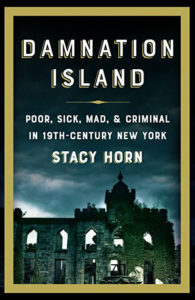When Blackwell’s Island was bought by the city of New York in 1828, the goal was to relieve the crowded conditions at Manhattan’s Bellevue, which in addition to being a hospital was also the location of the city’s Penitentiary, the Lunatic Asylum, an Almshouse for the poor, and the Workhouse, a prison for people convicted of minor crimes. As the city had grown, so had the number of the poor, the lunatic, and the criminal, all of whom had to be treated somewhere when they got sick.
“Why have we not establishments worthy of our city?” an expert they would consult later asked. On the lush, pastoral island of Blackwell’s, they were going erect state-of-the-art establishments, which would replace these facilities at Bellevue, and make up for any mistakes from the past.
The Workhouse was envisioned as a place for minor criminals, vagrants and the able-bodied poor. Small time criminals didn’t really belong in the Penitentiary, which was meant for people convicted of felonies, and poor people who were still capable of work didn’t belong in the Almshouse, which was intended for widows, the old and infirm, children, and the disabled.
The only truly effective way to eradicate poverty was to commit the poor (who were seen as the same as petty criminals) to institutions like the Workhouse, where the reasons for their destitution—their moral failings, and what was seen as their loathing of hard work—could be cured. How the Commissioners expected to accomplish this was made clear in the 1852 Annual Report, in which the first Superintendent of the Workhouse quoted another writer on the subject. “The Work House should be a place of hardships, of ample, though coarse fare; it should be administered with strictness—with severity; it should be as repulsive as is consistent with humanity … it is most unjust, as well as most detrimental to the moral being of the individual, to encourage him in idleness by the gratuitous offer of a better, at least, a sufficient subsistence.” .
A later warden would call the Workhouse “an almost complete model of what such an institution should not be …” The first problem was, as always, way too many poor people. The Commissioners who ran Blackwell’s Island always greatly underestimated the size of the populations they intended to serve (and reform). In 1850, 1,182 men were sentenced to the Workhouse. By the 1870s, 20,000 to 33,000 people were being sent to the Workhouse every year. The Workhouse soon had the largest and most transitory population on Blackwell’s Island. It also became the biggest correctional institution in New York City, and most of the inmates came from police court.
When someone was arrested in New York in the 19th century, they were first brought to the station house and then to police court. The police justice would then either discharge the prisoner, hold them for trial in one of the New York’s superior courts (the Court of Special Sessions for serious misdemeanors, or the Court of General Sessions for felonies), or, because the justices had the power to render judgments for ordinance violations and lesser misdemeanors, they’d either fine them or send them to the Workhouse.
Referred to as the “poor men’s courts,” the police courts operated like conveyor belts of sorrow.Referred to as the “poor men’s courts,” the police courts operated like conveyor belts of sorrow. One by one, people would step out of a pen and up to a rail in front of a raised platform, called “the bridge,” where the arresting officer stood above them, conferring with the judge out of earshot. Because they couldn’t hear, many didn’t find out they’d been sentenced to prison until they were shoved into a police van and taken to the 26th Street Pier.
Corrupt justices would dismiss the few cases of the wealthy and politically connected, or impose a fine or bail which they could easily pay. This left the unconnected poor, who couldn’t make bail and were instead sent to the Workhouse, (like arrestees today, who are sent to Rikers Island when they can’t make bail).
The justice’s power to sentence or pardon was tremendous, and lucrative. If bail was set at $500, the accused would have to either pay 10 percent of that amount to a bail bondsman or go to prison. The bondsman would then split the $50 among some combination of the police justice, the lawyer, the arresting officer, clerks, and others. On a good day they could be dividing up $1,000 or more.
There was almost no oversight. This was the poor and minor criminals after all, and few were looking out for them. Things finally got so out of hand that papers like the New York Daily Tribune blasted the system, writing that “no civilized community on earth was ever worse served than New-York has been under the administration of the police courts … They are not merely a reproach to this city, but a virulent poison which has infiltrated the body politic and is steadily spreading corruption.”
The police courts were abolished after an investigation in 1894, and replaced with the magistrates court. Justices now had to be attorneys-at-law, appointed by the Mayor. There was some improvement at first, but the abuses slowly resumed. By 1907 the situation was “so notoriously bad,” the Charity Organization Society of the City of New York pointed out an article published in Broadway Magazine titled “The Farce of Police Court Justice in New York: Magistrates, Lawyers, Ward Heelers, Professional Bondsmen, Clerks of the Court and Probation Officers join to Make a Mockery of ‘The Supreme Court of the Poor’.’” In the article, Franklin Matthews, a Night City Editor at the New York Times, described a heartless system that shook down and imprisoned their most vulnerable citizens (Matthews would go on to become one of the first professors at Columbia School of Journalism). The Society fought successfully for the appointment of what became the Page Commission, which investigated the courts, leading to the passage of the Inferior Criminal Courts Act in 1910 and further reforms.
Most of the people locked up in the Workhouse had been arrested for intoxication, disorderly conduct, vagrancy, or prostitution. For crimes like intoxication and disorderly conduct, those who could afford to paid a fine and were sent on their way, which again left only the poorest doing time. That time was usually brief. Although occasionally someone might receive a sentence as long as a year, and other sentences could be anywhere from one month to six, the majority of Workhouse sentence were ten days or less. Turnover, therefore, was high. And one particular group was going in and out of the Workhouse more than any other.
Although the female wing of the Workhouse was the last to be completed, by 1857, when the figures by gender began to be supplied regularly, the yearly totals for women were higher than the men’s, sometimes a lot higher, like during the Civil War years. That would continue to be true until 1883, when men finally started edging out the women in numbers. Still, for much of the second half of nineteenth century it would appear that more women were going to prison for minor crimes than men.
The problem is the yearly totals included “rounders” (repeat offenders), and do not represent the total number of unique individuals sentenced. It can only be said that women were sentenced to the Workhouse with greater frequency, and that may have been due to fact that judges were harder on women for the crime that was most likely get you sent to the Workhouse: disorderly conduct. According to Abbott’s Cyclopedic Digest of all the Decisions of all the Courts of New York From the Earliest Time to the Year 1900, disorderly conduct referred to “Offenses less than felony against the peace or good morals of the community.”
In practice, disorderly conduct meant whatever the police and the courts wanted it to mean.In practice, disorderly conduct meant whatever the police and the courts wanted it to mean and that was likely the intention behind the broad wording of the statute. What constituted proper behavior for a woman was narrower than what it was for men, and the law became, in part, a catch-all to keep women in line. The 1860 act lists street-walkers for instance, but not their customers. An 1888 police justice came right out and declared that for women only, simply being out at night was probable cause. The way he saw it, “no decent, respectable woman would be found in the street without an escort after 10 P.M.,” and therefore, he told a Women’s Prison Association investigator, “any woman alone in the street after that hour ought to be arrested.” Accordingly, at night police would sometimes sweep up women by the dozens. Although some of the women rounded up were undoubtedly prostitutes, the male criminals also out and about after ten were not picked up for just for being on the street after dark.
In 1893, Reverend Charles H. Parkhurst, who was waging a campaign against prostitution, would say that he didn’t care if working girls were thrown out of disorderly houses (a house of prostitution) to “starve or freeze on the streets,” as long as they were “starved and frozen” into another way of life. “If Doctor Parkhurst wishes to suppress this great evil,” activist Matilda Josyln Cage shot back, “he should turn his attention to the men … He can have every disorderly house watched, and every man entering it arrested, fined, and his name published. That would put a stop to it speedily.”
A committee investigating Police corruption in 1895 wrote how “in a number of cases women, who, as keepers of disorderly houses, had paid thousands of dollars for police protection, had become reduced to the verge of starvation, while those who had exacted blackmail from them were living in luxury …”
Fewer labor opportunities and lower pay meant that once convicted, women were less able to pay fines to avoid incarceration, so off to the Workhouse they went.
This was a more serious matter than being simply unfair. On Saturday, February 17, 1866, nineteen-year-old Fanny Little was picked up for the two crimes mostly likely to get you sent to the Workhouse: intoxication and disorderly conduct. Forty-two other people were arrested in New York that day, twenty-five men and sixteen women (the name of one arrestee was gender neutral). Some paid their fines or made bail and went home. But the highest bails imposed that day, $300 or $500, were all for women. Being drunk in public was inexcusable for a woman. One Annual Report of the Board of Police Justices bluntly stated that “public exhibitions of drunkenness in females indicate a depraved and abandoned condition,” while men were sometimes let off the hook because in their case there were often “circumstances to be taken in mitigation of punishment which rarely exist in cases of female.”
Fanny, whose bail was set at $500, was ultimately sentenced to five and a half months in the Workhouse. If she’d received even a slightly shorter sentence, she might have made it out of there alive.
On July 22, when she was a little less than two weeks short of being released, Fanny got sick. Twelve hours later she was dead, the first casualty of a cholera epidemic. Before it was all over, more people died of cholera on Blackwell’s Island than any other area in New York City, perhaps in part because police justices continued to send people there, even though the epidemic didn’t end until the last week in September. In total, 360 people died of cholera on Blackwell’s Island that year and the Workhouse was hit the hardest.
Exposés were written about the horrors of the Workhouse, but there was never a public outcry. Workhouse inmates were not seen as innocent victims, and were therefore underserving of sympathy. They had it coming. When Rikers Island was bought, and new institutions erected in the 1930s to replace those on Blackwell’s Island, a new Workhouse was among them.
__________________________________
Adapted from Damnation Island: Poor, Sick, Mad, & Criminal in 19th-Century New York by Stacy Horn © 2018 by Stacy Horn. Reprinted by permission of Algonquin Books of Chapel Hill. All rights reserved.





















